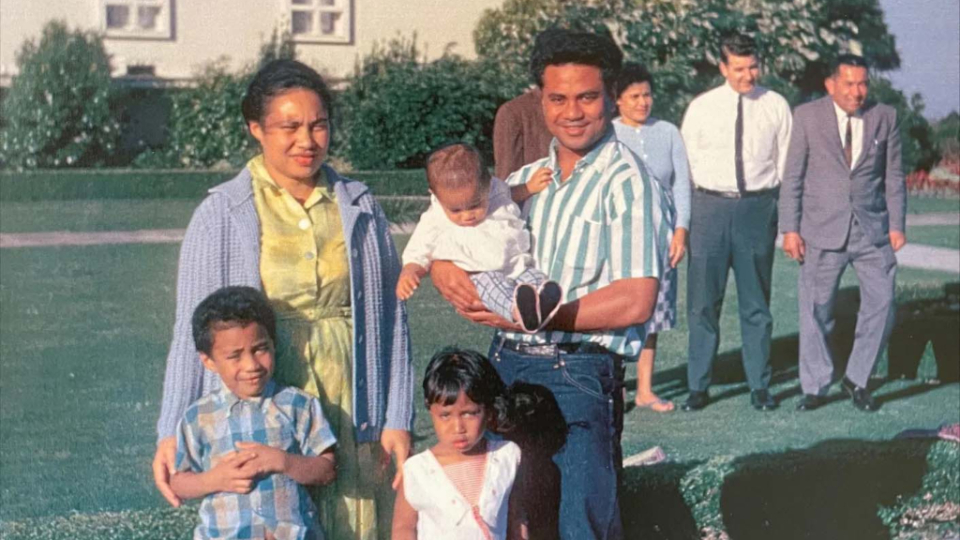
Vai-Sikahema-Photo-1.jpg
In this 1967 photo in front of the New Zealand Temple, the Sikahema family — parents Sione and Ruby and children Vai, Lynette and Kap — pause for a picture after having been sealed earlier in the temple. President John H. Groberg, in the white shirt in the background, was the mission leader in Tonga who traveled with a group of 100 Tongan Latter-day Saints to New Zealand. Photo courtesy of Elder Vaiangina Sikahema, courtesy of Church News.2022 by Intellectual Reserve, Inc. All rights reserved.
This story appears here courtesy of TheChurchNews.com. It is not for use by other media.
By Scott Taylor, Church News
Five-year-old Vai Sikahema stares shyly into the camera, standing with his parents, Ruby P. and Sione Sikahema, 3-year-old sister, Lynette, and 1-year-old brother, Kap, in front of the New Zealand Temple in a photograph taken more than a half-century ago.
That 5-year-old from Nuku‘alofa, Tonga, didn’t see the image until about a year ago, shortly after being called as a General Authority Seventy for The Church of Jesus Christ of Latter-day Saints. When first seeing and holding the 8-by-10-inch print from a slide, Elder Vaiangina Sikahema openly wept.
What the image depicted was meaningful and touching on so many levels.
First, the photograph captures the Sikahemas outside the temple on a sunny October day in 1967, just after the family had been sealed.
And it is a rare photo of the family from that era, so it quickly has become a treasured keepsake.
In the background with another couple stands President John H. Groberg — the mission leader in Tonga in the late 1960s and later a General Authority Seventy — who accompanied a group of about 100 Tongan Latter-day Saints that year to the temple in Hamilton, New Zealand. Behind the camera taking the photo was his wife, Sister Jean Groberg. So the image also underscores the link between the Grobergs, the Church in Tonga, and the support of family members and friends assisting those traveling to the temple.
The photograph also represents the role of the New Zealand Temple as the Church’s sole temple in the South Pacific for a quarter-century after its 1958 dedication, until temples were built in Australia, Tonga, Samoa and Tahiti in the early to mid-1980s.
“For many of whom I would call ‘the pioneer Saints of the Pacific,’ the New Zealand Temple has remained a beacon of hope, where we could go and receive all of the blessings of exaltation in the temple, with the ordinances being available to us,” Elder Sikahema said. “It was incredibly powerful for us, even for those of us who were too young to understand what was really going on.”
Today, the Church has 17 operating, under-construction or announced temples within its Pacific Area. With the first — today known as the Hamilton New Zealand Temple —rededicated on Sunday, October 16, 2022, following a four-year renovation closure, the Sikahemas’ experiences are representative of those meaningful and touching events on so many levels for so many Latter-day Saints.
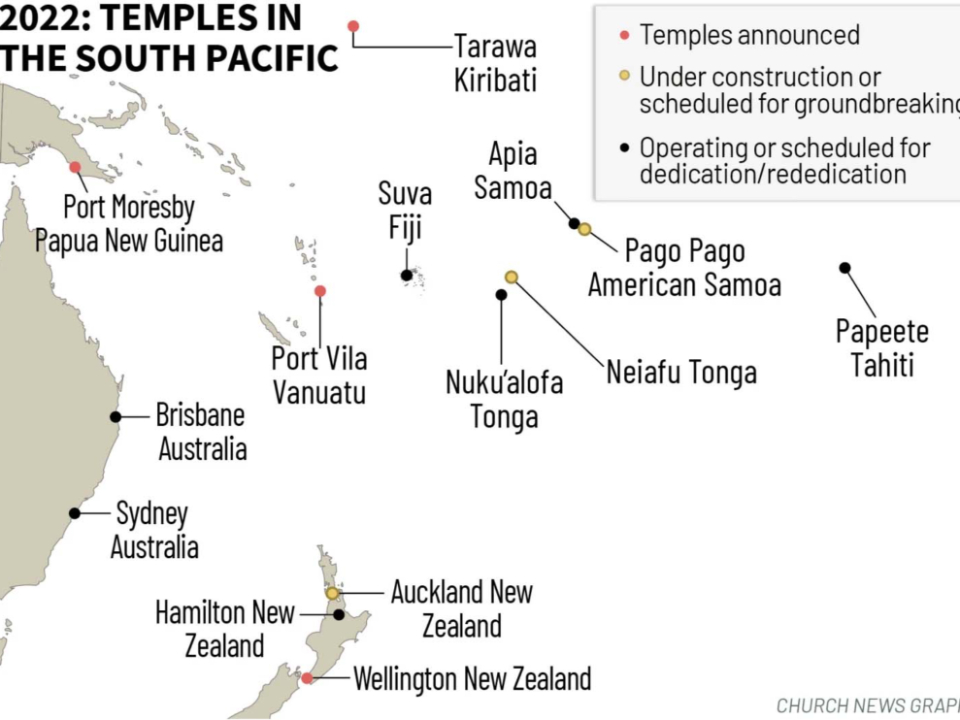
Vai-Sikahema-photo-3
Temples of The Church of Jesus Christ of Latter-day Saints in the South Pacific. Graphic courtesy of Church News.All rights reserved.
Preparation
Like others throughout the area, Tongan Latter-day Saints sacrificed to travel great distances to attend the temple. “As soon as a couple got married, even before they were married, they started saving, as encouraged by local leaders,” Elder Sikahema recalled.
Married in 1961, Sione and Ruby Sikahema became dorm parents at Liahona High School, providing room and free cafeteria meals but little more. Ruby’s work with the Church’s translation services in Nuku‘alofa provided some supplemental income.
Additional savings came from the Sikahemas selling produce like corn, melons and yams from their large garden. “It was one of my jobs as a 5-year-old to sort melons by size to sell, and it was all done in the home,” Elder Sikahema said. “People did whatever they could, so it’s a warm memory for me that I participated in some small way.”
Latter-day Saints also reached out to family members and friends in New Zealand, the United States and elsewhere to see if they could help contribute to their temple-trip savings.
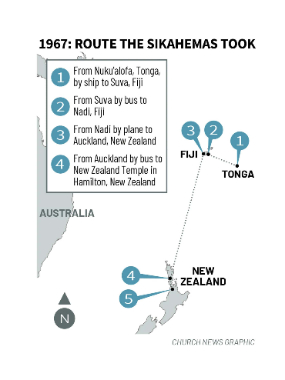
Vai-Sikahema-photo-4
The route the Sikahemas took to get to the Hamilton New Zealand Temple from Tonga included a ship to Fiji, a bus across Fiji, a plane to Auckland, New Zealand, and then a bus to Hamilton. Graphic courtesy of Church News.All rights reserved.The Trip
The Tongan group left Nuku‘alofa in 1967, traveling by ship bound for Suva, Fiji, then crossing that island by bus to Nadi, then flying to Auckland, New Zealand, and on to Hamilton by bus again. “I remember the excitement of the trip,” recalled Elder Sikahema, citing Charles Dickens’s “pick and flower” description of emigrating English Latter-day Saints when thinking of those in his own group.
“That’s how I feel about these Tongan Saints that made the trip,” he said, mentioning some by name, such as the Fifita Sitake family, the grandparents of Brigham Young University head football coach Kalani Sitake. “The Lord has continued to bless our families in remarkable ways.”
While almost half of the group were children, there could have been even more. Many large families didn’t have enough money for every child to travel, so some had to decide which ones came along and which ones didn’t. Sometimes parents opted for bringing young children, thinking that older children might have temple experiences as students at Church-sponsored colleges or getting mission calls.
“Nobody has to make that kind of choice now — ‘Which kids do I take with me to be sealed in the temple?’ Talk about having to choose, having a difficult choice,” Elder Sikahema said.
Height and Heaven
One enduring memory Elder Sikahema has was the flight’s high-altitude reach. “I doubt that any of the men or women on that plane had ever been any higher than the height of a coconut tree,” he said, adding that that’s about the same height as Nuku‘alofa’s then-tallest building, a two-story edifice with the mission office and translation department on the upper floor.
When the plane lifted off the runway, the Tongans had their window shades up and were looking out the window. “The adults are all yelling — Tongans aren’t shy — and everybody’s screaming,” Elder Sikahema recalled. “I’m sure the pilot was like, ‘What is going on back there?’ It was just a collective scream.”
Another memorable moment followed. Elder Sikahema remembers an older woman by the name of Meleame who was sitting behind him and crying on the flight. When President Groberg came over to check on her, she asked him, “Kolipoki, ko hevani eni?” — or “Groberg, are we in heaven?”
Said Elder Sikahema: “In the context of an elderly Tongan person who had never been in an airplane and to look out and be above the clouds, she wondered if we were in heaven. And Elder Groberg responded, ‘Yes, we are in heaven, because heaven is with your loved ones, and heaven will be just like this.’”
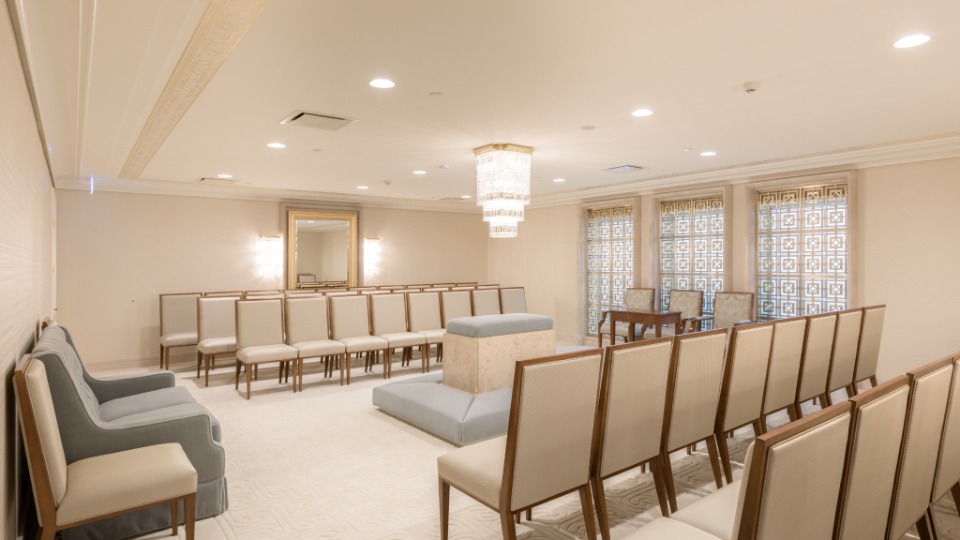
Hamilton-New-Zealand-Temple-Sealing-Room
Sealing room in the Hamilton New Zealand Temple.© 2022 by Intellectual Reserve, Inc. All rights reserved.
The Day
Elder Sikahema’s recollections of the day of the temple sealing include waiting with all the Tongan children in the temple nursery. “Think of the poor nursery leaders and these kids who had never seen toys — it was like we were let loose in Disneyland.”
Walking to the sealing room with Lynette and a temple worker carrying Kap, he could see his parents —dressed in white, kneeling at the altar — through the open doorway. Upon seeing her children approaching, his mother let out an audible gasp and starting to cry. “We weren’t sure what was going on,” he said of the siblings joining for the ordinance, “but I’m grateful I have a memory of that.”
His younger siblings don’t remember the actual moment. “But they have memories of growing up and hearing my parents talk about it, teaching about the importance of the temple and being sealed.”
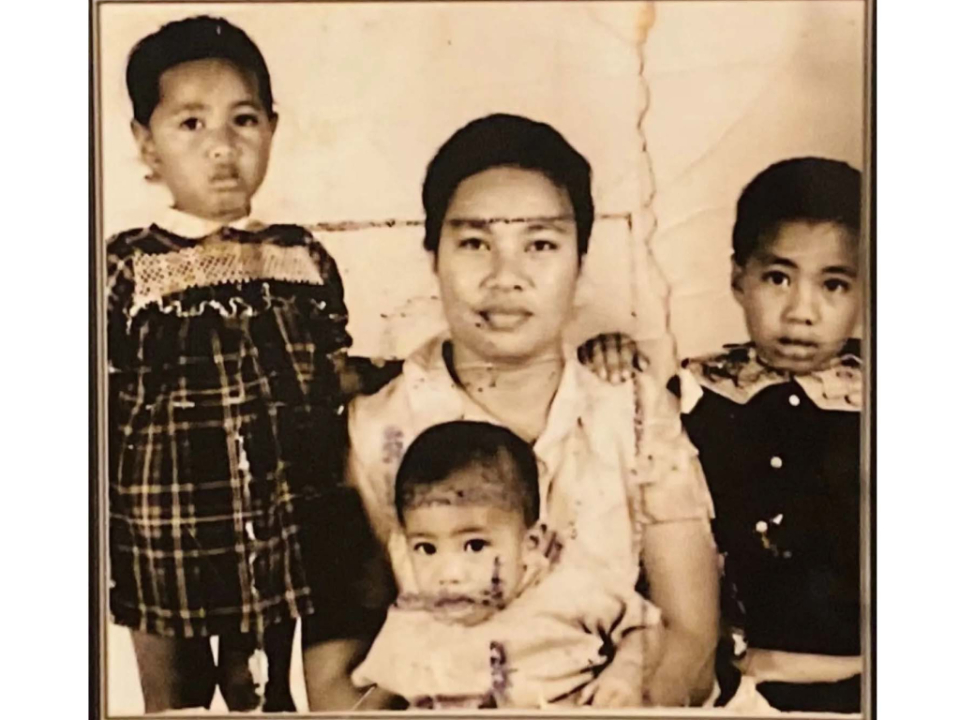
Vai-Sikahema-photo-5
The 1967 passport photo shows Ruby Sikahema with her three children — from left to right, Lynette, Kap and Vai. The Sikahemas traveled from Tonga to New Zealand to go to the temple in Hamilton. Photo courtesy of Elder Vaiangina Sikahema, courtesy of Church News.All rights reserved.
The Photos
Elder Groberg and his daughter Liz were going through slides and photographs around the time of Sister Groberg’s passing in early October 2021 when they found one of a young family at the temple in 1967. Determining the slide was of the Sikahemas, they made and sent the enlargement.
“I just wept because I had never seen a picture of my family together,” Elder Sikahema said. “That was the first time I ever saw a photo of my parents at those ages.”
Another photo from the temple trip resurfaced about the same time — the passport for Ruby Sikahema and her children. Tongan passports at the time allowed children to be photographed with a parent.
“It’s probably been in the family, but it emerged from somewhere recently. That passport photo was probably the first time we ever sat and had a photograph taken of us,” he said, adding “I’m sometimes envious of people my age — I’m 60 — who have baby pictures of themselves and their family pictures. We don’t have any.”
The Sikahemas were photographed at times previously. “If you were fortunate to know American missionaries, most of them brought good cameras. But a lot of them didn’t get the photos developed there in Tonga, but when they returned back to America,” Elder Sikahema said.
The Return
In the photograph, President Groberg stands by Percy and Anna Harris, Ruby Sikahema’s aunt and uncle. Financially well off and living in New Zealand, they not only assisted the Sikahemas with travel costs but also helped put up the Sikahemas for their three months in New Zealand.
For the Sikahemas, it wasn’t a temple trip of a week or two. Elder Sikahema later learned his parents had secured enough for a one-way passage, with faith to find work and save to return home.
Local Latter-day Saints helped the Tongan members with work opportunities. Elder Sikahema remembers going with his father one day to shear sheep on a ranch. “It wasn’t work that Tongans were familiar with, but they were taught how to do it.”
It took the family six years to save to go to the temple — and three months to earn enough to return home.
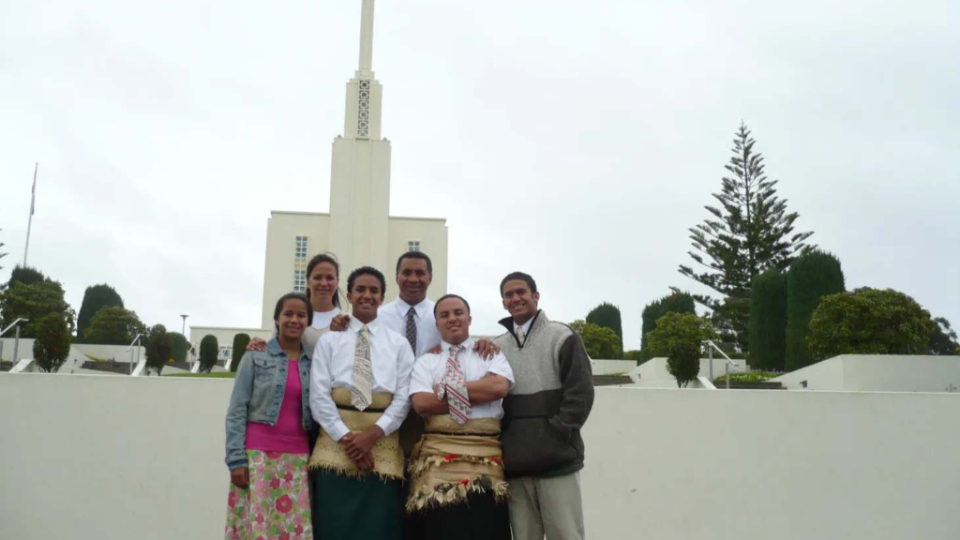
Vai-Sikahema-photo-6
Elder Vaiangina Sikahema and his wife, Sister Keala Sikahema, and their four children pause for a photo outside the Hamilton New Zealand Temple in 2007 as the family retraced Elder Sikahema’s roots on a trip to Tonga, New Zealand and Hawaii. As a young boy int 1967, Elder Sikahema had been sealed to his family in that temple. Photo courtesy of Elder Vaiangina Sikahema, courtesy of Church News.All rights reserved.
Postscript
In 1969, Ruby and Sione Sikahema left for Laie, Hawaii, to attend BYU–Hawaii; young Vai joined them there in 1970, and the three went on to Mesa, Arizona, where his father’s brother lived. The two youngest children were cared for by family in Tonga until they arrived in Mesa in 1972.
“So, three and a half years of separation ...” Elder Sikahema’s voice trails in tender reflection. “But we had been sealed.”
The blessings of that temple ordinance have been manifested to and credited by the Sikahemas throughout their life experiences, from physical and spiritual protections to educational and employment successes. The New Zealand Temple was a highlight when Elder Sikahema took his wife, Sister Keala Sikahema, and their four children on a roots-retracing trip in 2007 to Hawaii, New Zealand and Tonga. The 1967 family sealing also brought an eternal perspective to Ruby Sikahema’s passing in 2013.
“We’ve been enormously blessed, and it’s traced back to October 1967,” Elder Sikahema said.
“And I honestly don’t think our experiences were all that unique,” he added. “It was happening among the Fijians, the Samoas, the Maori, people in Vanuatu, Kiribati — all up and down the Pacific.”
Such experiences were meaningful and touching on so many levels for so many Latter-day Saints — and sometimes captured in photographs.
Copyright 2022 Deseret News Publishing Company.